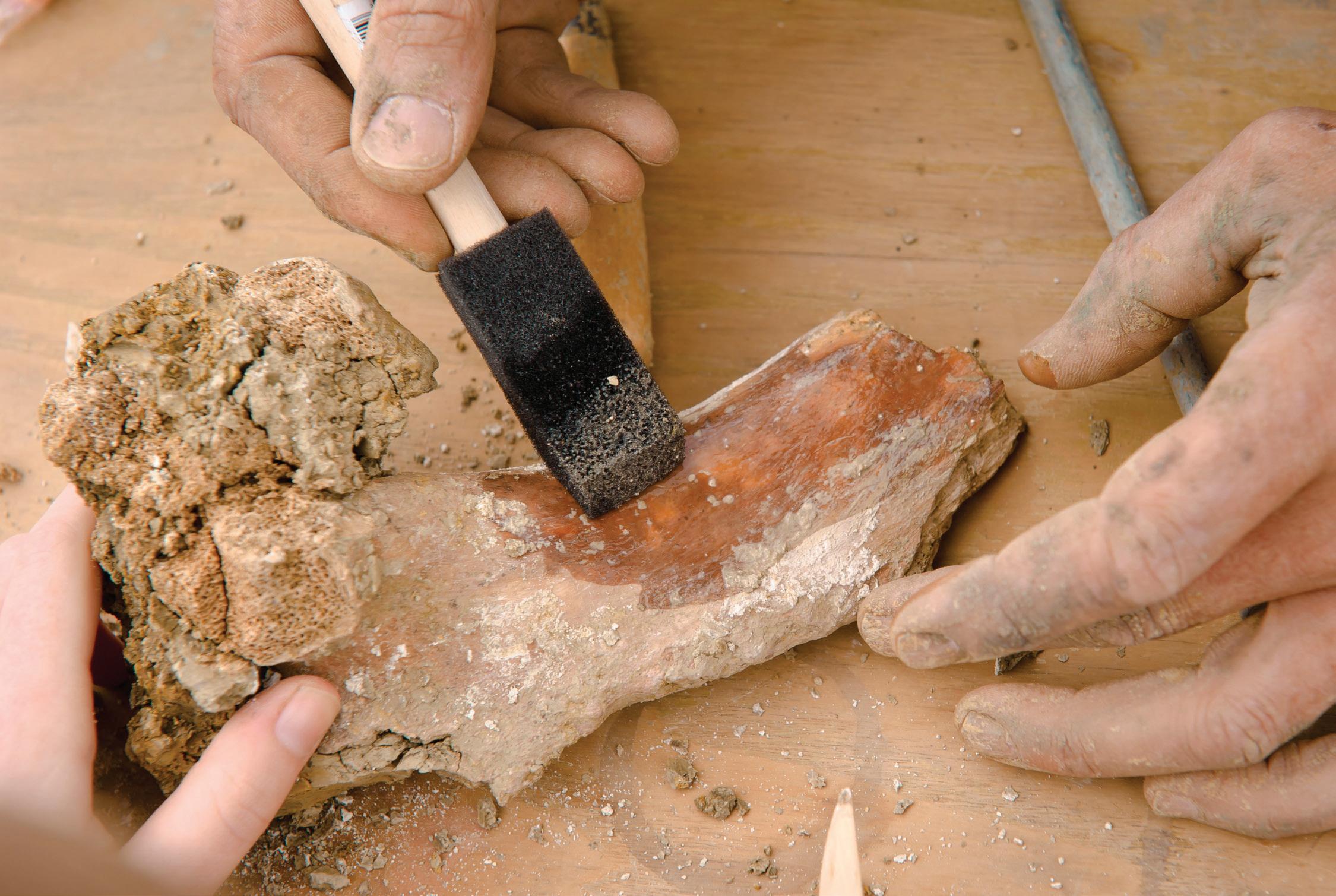




Recently, while preparing his land for planting, a farmer in Castroville unearthed what he believed to be bone. After contacting Mark Hylkema, the Bay Area regional archeologist for California State Parks, it became clear that the discovery was not just any bone— it was a molar from a Columbian mammoth (Mammuthus columbi). Hylkema quickly formed a team of colleagues with expertise in archaeology and paleontology and set to work excavating and documenting this rare find. The farmer understood the value of the find and postponed planting so the team would be able to excavate as much of the mammoth as possible.
The discovery of the tooth, part of the remains of what the scientists believe is a male mammoth in its early 30’s, has led to much more – including bones of a Jefferson’s Ground Sloth (Megalonyx jeffersonii), American Mast-
odon (Mammut americanum) teeth and skull fragments, bones of an ancient American Camel (Camelops hesternus), and the remains of fossil salamanders, snakes and mice. “We managed to recover and organize about one third of the mammoth’s bones in the time we had, including the tusks. They are extremely fragmented, and are currently being meticulously cleaned and studied,” says Hylkema. The remains were found in what was a tributary of Elkhorn Slough. Samples of the sediment there are being studied for microfossils, including pollen grains and fossils of aquatic microorganisms. Analysis is expected to reveal important clues as to what life was like in the vast wetland complex that dominated the lower Salinas, Elkhorn and Pajaro river valleys thousands of years ago. Scientists from UCLA and UC Berkeley will radiocarbon date the remains to
determine the age of the bones, and UCSC researchers are looking at isotopes to analyze the mammoths’ diet. “We’ll be able to tell if they grazed along the coast or in interior grasslands,” says Hylkema.
In addition to the bones, the team has also uncovered mammoth hair. The Columbian Mammoth – a larger southern relative of the better-known Wooly Mammoth – did not live in the colder northern locations that tend to preserve hair or other soft tissues, making this a rare find. In fact, there has been only one other suspected find of Columbian Mammoth hair. “Technically, we may have the first-ever reported and verified finding of mammoth hair,” says Dr. Tim King, Project Coordinator for the excavation. “When the DNA results come back, we may be able to officially confirm that we
continued on page 7
Elkhorn Slough Foundation
Board of Directors
Steve Webster
President
Steve Dennis
Vice President
Richard Hammond
Treasurer
Steve Green
Secretary
Ed Boutonnet
Judith Connor
Terry Eckhardt
Bill Eggleston
Anne Olsen
Mike Pinto
Anne Secker
Lydia Villarreal
Tom Williams
Mary Wright Staff
Mark Silberstein
Executive Director
Kate Raymundo
Administrative Director
Kim Hayes
Stewardship Director
Ken Collins
Land Steward
John Kenney
Farmland Manager
Kevin Contreras
Land Acquisition Specialist
Gabriele Estill Grants Manager
Lorili Toth
Director of Development & Communications
Quinn Labadie
Development & Communications Manager
Jessica Perri Office Manager
PO Box 267, Moss Landing California 95039
Tel: (831) 728-5939
Fax: (831) 728-7031 www.elkhornslough.org
Tidal Exchange
Editor: Quinn Labadie

The Elkhorn Slough Foundation has been working with Ocean Mist Farms of Castroville for more than a decade, and during that time we’ve cooperated on the restoration of 183 acres of former fields to wetland habitat. Ocean Mist and their related enterprises are the largest producer of artichokes in the United States. The company employs more than 1,500 people and cultivates thousands of acres in the lower Salinas Valley.
“We learned about the value this land could have to help restore wetlands and had confidence that the Foundation would be a good steward of the land,” says Afreen Malik, Ocean Mist’s Food Safety & Environmental Stewardship Manager.
ESF worked with Ocean Mist to reconfigure the land, channeling runoff into two ponds on the restored property. As water flows through the newly created wetland ponds, sediment and nutrients are naturally filtered. Studies by Dr. Gage Dayton, now of UC Santa Cruz, demonstrated that the Moro Cojo wetlands are particularly effective at transforming nitrates, reducing them to significantly lower levels as water traverses the wetland system. In addition, the restoration site has created habitat for an extraordinary diversity of migratory and resident birds. We’ve previously reported on the research by Rick Fournier who has identified over 150 species of birds using the land since it was restored.
The work on the Sea Mist restoration site provides an example of linking economically productive farms with the benefits of wetland restoration, nutrient management and habitat creation.
“ESF’s goals align closely with Ocean Mist Farms’ environmental stewardship program,” says Ocean
Mist Farms CEO Ed Boutonnet, who recently joined the Board of Directors at the Elkhorn Slough Foundation.
“Partnering with ESF provides another opportunity for Ocean Mist Farms to have a support environmental conservation. ESF, by serving as an educational hub, is also helping lay a foundation of learning and understanding that is essential today and for generations to come. We want to be a part of this effort.
We believe that ESF is a responsible steward of the local environment and, as such, can be a valuable partner for any business.”
We are pleased to acknowledge Ocean Mist as a member of our Land Partner Circle. To learn more about our Land Partner Circle and other opportunities for business support of Elkhorn Slough Conservation contact our Development Department.

Researchers in the slough had the rare privilege of witnessing an otter give birth with their own eyes late this April. Robert Scoles and Nichole Rodriguez spotted an otter on a mud bank in Parsons Slough while collecting data on marine mammals. The otter was behaving strangely, and researchers thought she might be injured until she reached down and retrieved a small, healthy otter pup.
The new mother’s instincts immediately kicked in as she groomed and inspected her new baby. Just an hour and a half after being born, the pup was taken back to the water with mom, where it had its first meal. The pup will be too buoyant with its fluffy fur to forage for itself for several months, so mom will nurse it and forage for it until the baby can dive underwater on its own.

The sight of a wild Southern sea otter birth is exceptionally rare, but Nichole managed to capture photos of the newborn otter by holding her cell phone to a viewing scope, memorializing the event at a safe distance from the mother. The video is posted on the Elkhorn Slough Foundation website.
Monitors have been observing marine mammals in Parsons Slough over the past year and a half, as part of an ongoing study to document marine mammal use of tidal wetlands. The study complements efforts by ESNERR and ESF to track marine mammal usage of Parsons Slough after the recent completion of the wetland restoration project there.
Marine mammals are easily spotted in the slough, especially around Seal Bend or the Moss Landing Harbor. One of the reasons these populations are thriving in the slough is that visitors are mindful of keeping their distance. Keeping far enough away from all species of marine mammals so their behavior does not change is both a sound practice and a legal requirement.
The monitors continue to track the mother and pup and have identified additional mother-pup pairs using the slough. From baby mammoths, to baby otters and sharks, Elkhorn Slough’s reputation and function as an important nursery continues to grow!

Forthe second year in a row ESNERR’s Freshwater Ecologist Nina D’Amore, PhD, has found evidence of endangered Santa Cruz longtoed salamanders breeding in the Elkhorn Slough watershed.
Amphibians such as the Santa Cruz long-toed salamander are sensitive to water quality impairment and disturbances, making them sentinels of environmental and ecosystem health; hence protecting this rare species, and others like it, is essential. Restoration projects both to improve upland habitat acquired by ESF and to directly enhance breeding grounds in ESNERR’s Cattail Swale appear to be doing exactly that.
“This is an exciting find, and an indication that the restoration actions undertaken have made a real difference for this endangered species,” says Nina.
In 2007 ESF purchased a 24 acre property near the Elkhorn Slough Reserve. ESF fallowed the steep, eroding land and began transitioning it to its historic state as an oak forest. By fallowing this land and working to give it a more natural vegetative cover, ESF’s stewardship team has made strides in protecting the soil on the property. These protective steps have reduced erosion and prevented sediment and nutrients from flowing into one of only 22 known Santa Cruz long-toed salamander breeding ponds—Cattail Swale.
Lower Cattail Swale can be seen from the South Marsh Loop on the Elkhorn Slough Reserve where it is studied and stewarded. In winter of 2008-2009 ESNERR undertook a major restoration effort to improve the habitat there. The pond was made deeper, which increased the area’s water retention and gave freshwater species a longer window of time in which to breed.
Improved upland habitat, increased runoff filtration, and extended wet seasons—all of these efforts seem to be adding up. After a five year hiatus, endangered salamanders are once again breeding in Elkhorn Slough.

Mark Silberstein, ESF Executive Director
Each year we are humbled by the long list of dedicated and generous individuals, businesses, foundations, and agencies that support the conservation and restoration Elkhorn Slough and its watershed. We are grateful to each and every one of you.
Our work depends on support that comes in countless forms. Each year hundreds respond. For many the response includes a generous gift of time and energy through volunteerism. Of course, much of our support comes through our members that contribute annually and, often, reach even deeper when asked to give at specific opportunities such as in support of our Endowment, which will help fund Elkhorn Slough conservation long into the future.
In fact there are many ways that you can make a gift to Elkhorn Slough Foundation. The most common is annual giving through membership, which supports our day-to-day efforts. Many of our members plan today for a future gift that comes in the form of a bequest articulated in their will or in trust documents.
These two ways of giving represent either end of a charitable spectrum – the first providing immediate support and the latter representing a final communication of a philanthropic heart. But between these two points on the giving spectrum there exist a number of ways to provide critical support for slough conservation – which can even have dramatic impact on helping you meet your long and short-term financial objectives.
Tax benefits are part of nearly every donation to a qualified charity. In many situations, however, it is possible to receive more than just a charitable income tax deduction. Some giving methods make it possible to bypass capital gains taxes on appreciated assets, significantly reduce estate taxes, and even establish a whole new source of income for you and your family.
Contributing to any charity is a very personal matter. Giving out of passion is all any charity can ask of its donors. Yet, you may find that a dollar’s worth of value can be dramatically increased. The critical ingredient is careful planning, and if you are interested in learning about some of the tools to help magnify your charitable giving to conserve the Elkhorn Slough, please call Lorili Toth in our Development Department.
One thing is certain, no matter what form your philanthropic expression may take, there is no way we can adequately express the value of your friendship and support. Thank you.
continued from front page
do indeed have the only known samples of Columbian Mammoth hair.” The hair is being sent to a Pennsylvania State University paleogeneticist to unravel the mammoths’ DNA sequence, something that has never been done before with this species. This information will help us understand how the Columbian Mammoth and Wooly Mammoth are related to each other and how they are related to modern elephant species.


This fossil discovery has such importance for better understanding the Columbian Mammoth and for local natural history that everyone involved with the excavation is volunteering their time. The work being done by these experts, and a small army of students doing the digging, will tell us all more about what life was like in Elkhorn Slough more than 10,000 years ago. For now, the imagination runs wild with visions of an ancient landscape populated by lumbering mammoths, mastodons, giant ground sloths and camels.

P.O. Box 267
Moss Landing, CA 95039
Join us!
If you’re not yet a member of Elkhorn Slough Foundation, we hope you will join today. Your membership directly supports the conservation and restoration of one of California’s last great estuaries and the abundance of life centered here.
Members receive a 10% discount at the Elkhorn Slough Bookstore located in the Reserve Visitor Center and invitations to ESF member events, including walks on our lands and kayak tours of the Slough. We will keep you informed of our work through Tidal Exchange and our online news alert, Slough Buzz

Elkhorn Slough National Estuarine Research Reserve & Visitor Center 1700 Elkhorn Road, Watsonville, CA (831) 728-2822
Open Wednesday–Sunday, 9:00 a.m.–5:00 p.m.
Early Bird Tours First Saturday each month, 8:30 a.m.
Join expert Rick Fournier for early birding. Meet at the Visitor Center; $2.50 day-use fee.
Docent-led Tours of the Reserve Saturdays & Sundays 10:00 a.m. & 1:00 p.m. Tours meet rain or shine at the Visitor Center; $2.50 day-use fee.
ESF MEMBER EVENTS- RSVP online or call Quinn at 728-5939:
NEW MEMBER SUNSET WALK - Thursday, August 18
MEMBER KAYAK TOUR - Sunday, October 9
FALL NATURE WALK - Saturday, October 22
FALL BIRDING WALK - Saturday, November 12
Please check our website for more details on these events. We look forward to seeing you soon. www.elkhornslough.org